Abstract
The management of penetrating wounds of the heart has been controversial. During the last 10 years we have used 3 different therapeutic approaches for the treatment of these wounds and the obtained results comprise this report. From 1964 to 1974 we treated 102 patients, four of whom expired immediately after their arrival to the clinic. The remaining 98 patients were divided into five groups according to their clinical presentation and treatment. Group I, 17 patients (14 with stab and 3 with bullet wound) seen with cardiac tamponade from 1964 to 1967 were treated first with pericardiocentesis and then were operated upon if pericardiocentesis yielded no results or if cardiac tamponade recurred. Fourteen patients recovered and three died, with an overall mortality of 17.5% Group II, 34 patients (23 with stab and 11 with bullet wound) were seen with cardiac tamponade from 1968 to 1971. The patients with stab wound were managed the same as group I patients and those with bullet wound were operated upon immediately. Twenty-nine recovered and 5 died, with an overall mortality of 14.7%. Group III, 20 patients (12 with stab and 8 with bullet wound) were seen with cardiac tamponade from 1972 to 1974. All of them were operated upon immediately and pericardiocentesis was used in this group only to provide time for a safe operation. Nineteen recovered and one died, with an overall mortality of 5%. Group IV, 20 patients (5 with stab and 15 with bullet wound) with massive bleeding, were operated upon immediately. Ten (4 out of the 5 with stab and 6 out of the 15 with bullet wound) recovered, with a mortality rate of 50%. Group V, seven patients were seen throughout the study period without bleeding or cardiac tamponade. Some of them were operated upon electively and others are being followed and all have done well. This study suggests (1) that patients with penetrating wound of the heart and cardiac tamponade or bleeding will derive better results if they are operated upon as soon as possible and if pericardiocentesis is used to provide time for a safe operation and (2) that those with other manifestations should be evaluated and if their lesion is significant, they should be operated upon electively.
Full text
PDF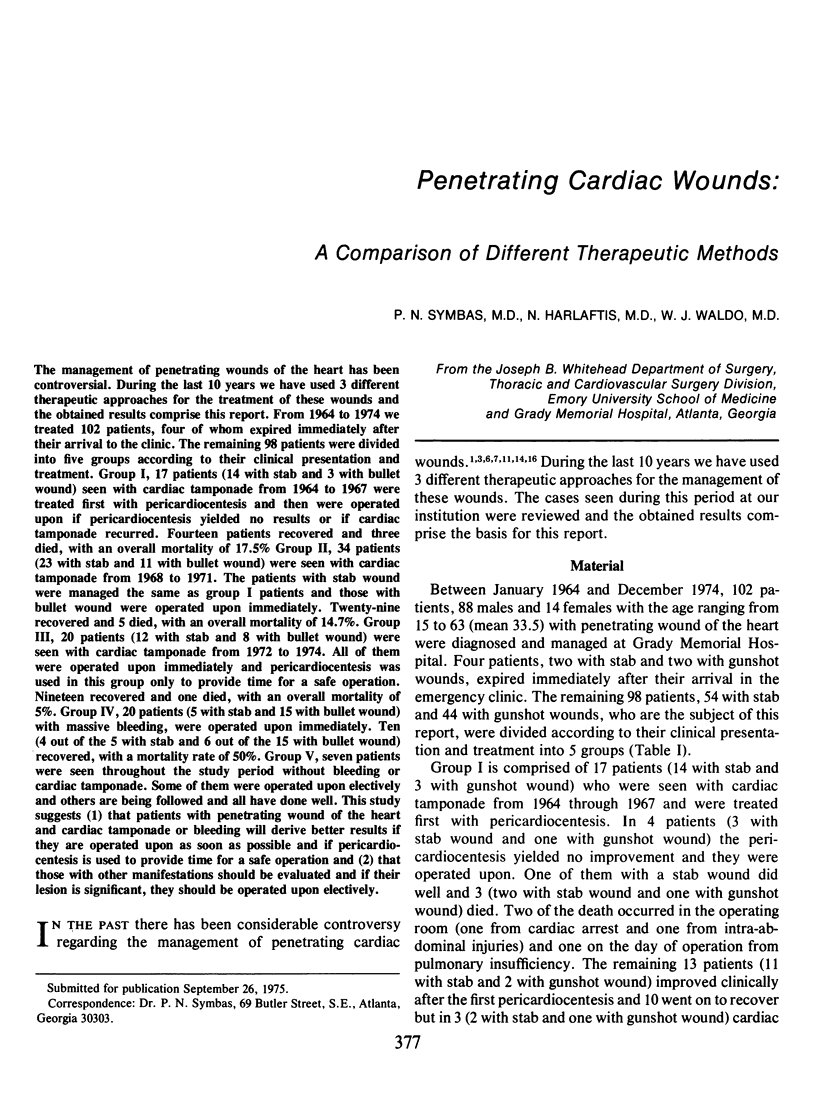
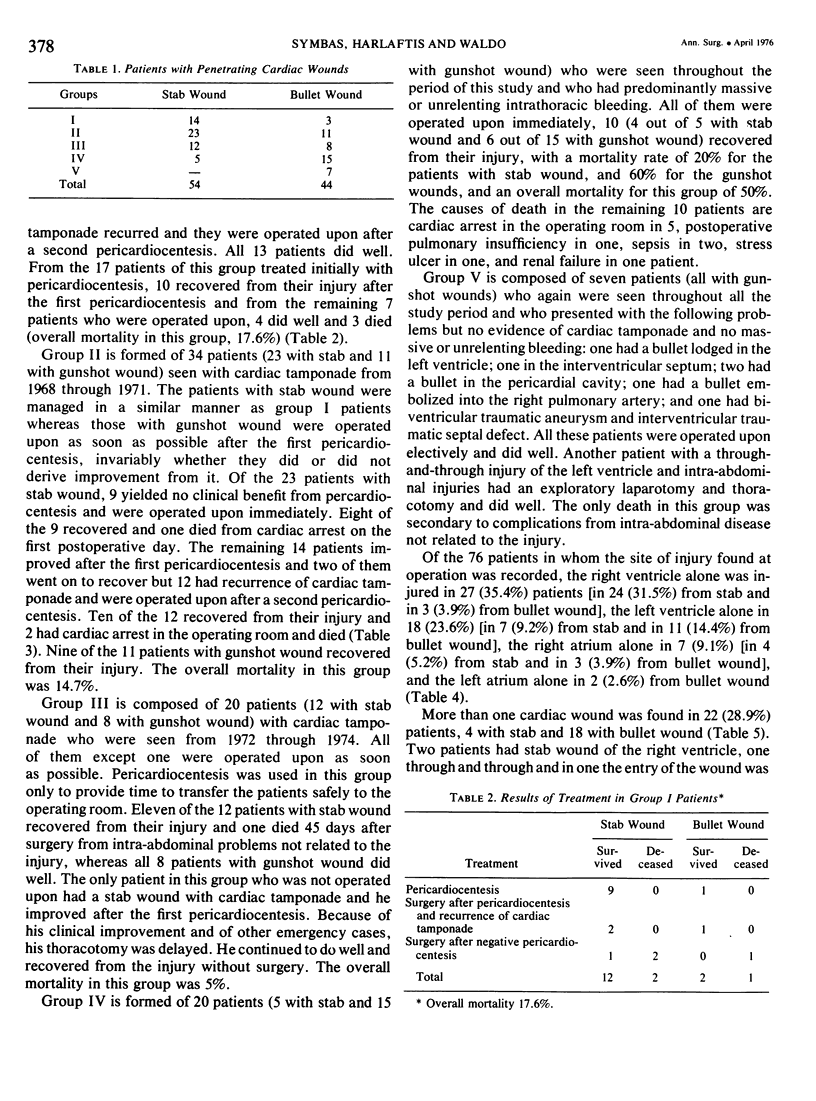
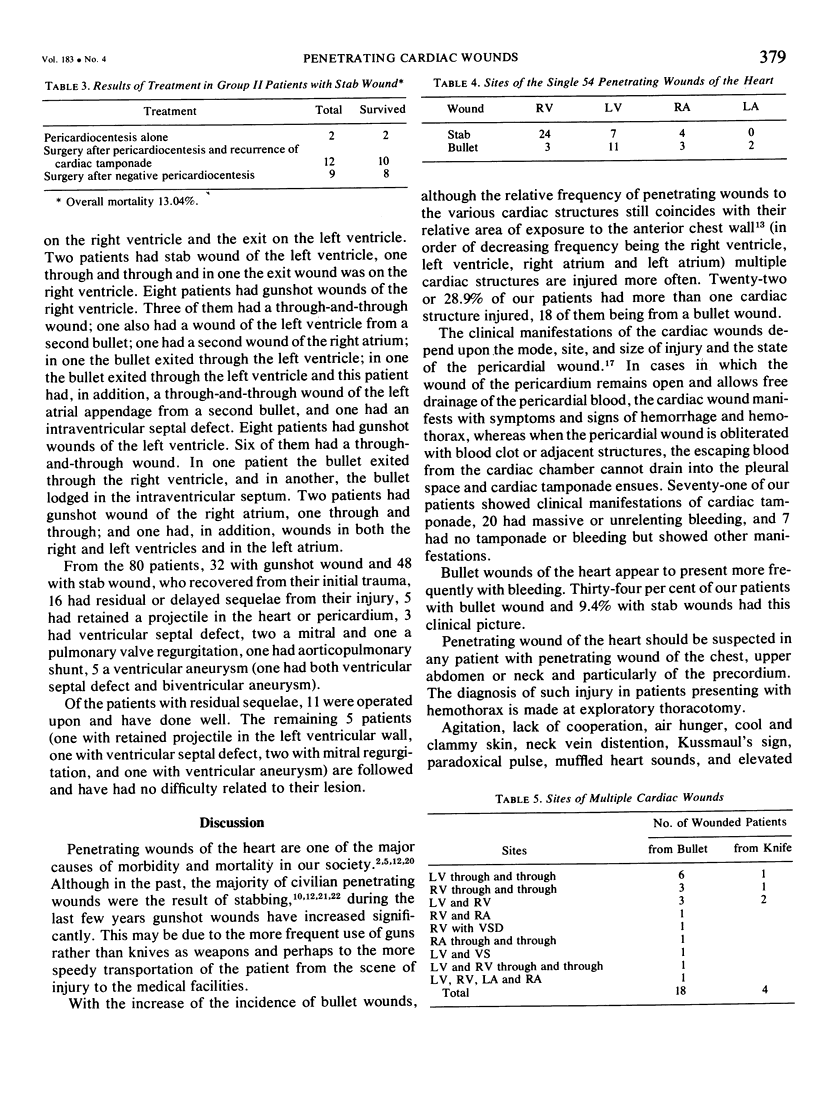
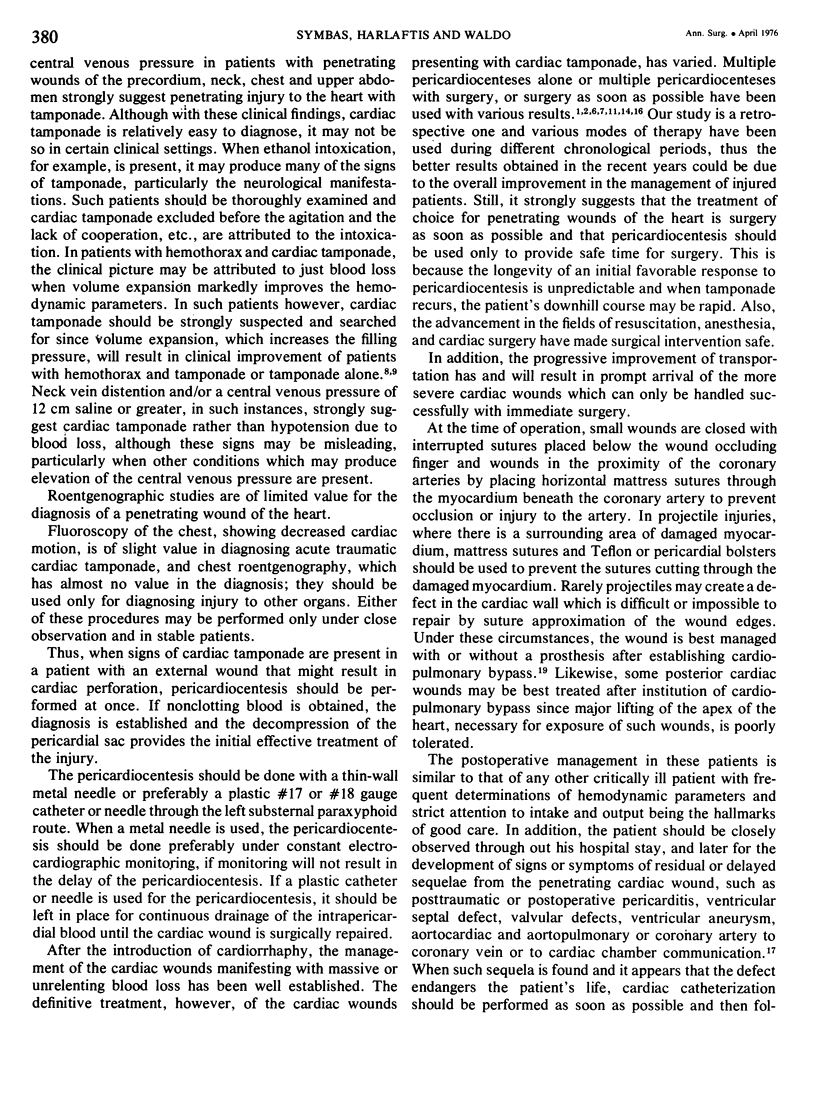
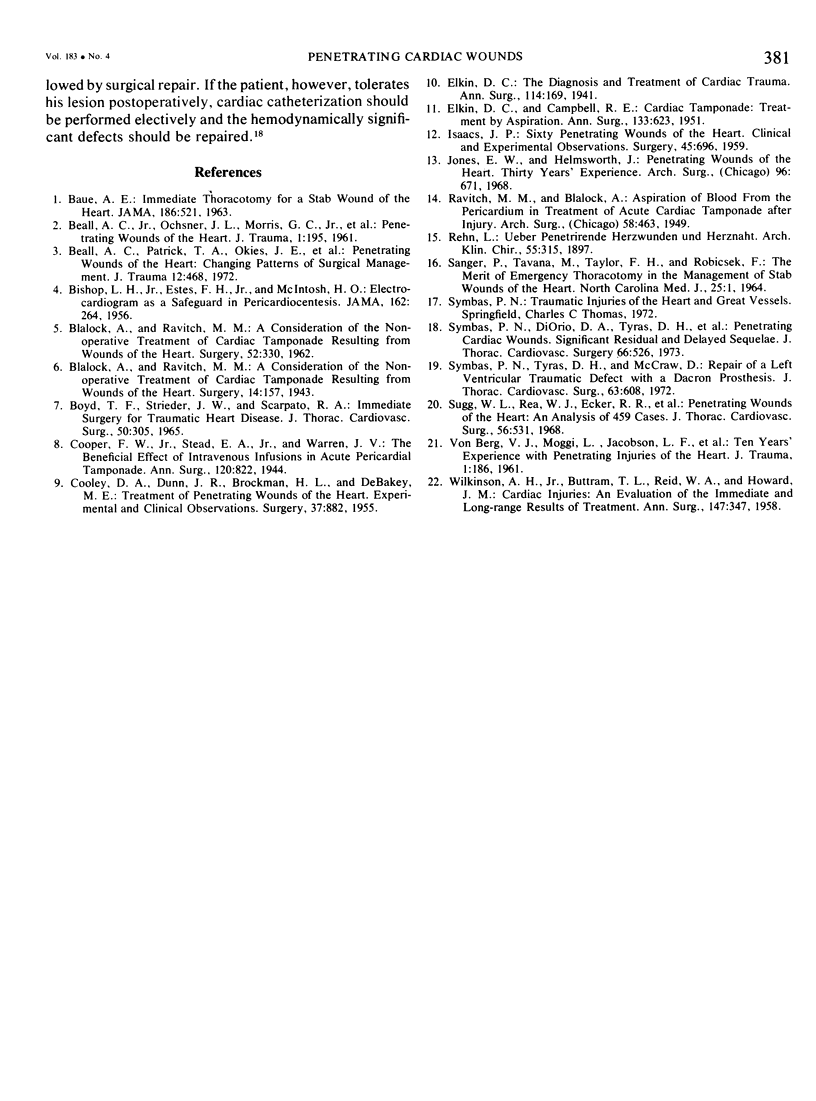
Selected References
These references are in PubMed. This may not be the complete list of references from this article.
- BAUE A. E. IMMEDIATE THORACOTOMY FOR A STAB WOUND OF THE HEART. JAMA. 1963 Nov 2;186:521–521. doi: 10.1001/jama.1963.63710050041021d. [DOI] [PubMed] [Google Scholar]
- BEALL A. C., Jr, MORRIS G. C., Jr, COOLEY D. A. Temporary cardiopulmonary bypass in the management of penetrating wounds of the heart. Surgery. 1962 Aug;52:330–337. [PubMed] [Google Scholar]
- BEALL A. C., Jr, OCHSNER J. L., MORRIS G. C., Jr, COOLEY D. A., DEBAKEY M. E. Penetrating wounds of the heart. J Trauma. 1961 Mar;1:195–207. doi: 10.1097/00005373-196103000-00011. [DOI] [PubMed] [Google Scholar]
- BISHOP L. H., Jr, ESTES E. H., Jr, MCINTOSH H. D. The electrocardiogram as a safeguard in pericardiocentesis. J Am Med Assoc. 1956 Sep 22;162(4):264–265. doi: 10.1001/jama.1956.02970210004002. [DOI] [PubMed] [Google Scholar]
- BOYD T. F., STRIEDER J. W. IMMEDIATE SURGERY FOR TRAUMATIC HEART DISEASE. J Thorac Cardiovasc Surg. 1965 Sep;50:305–315. [PubMed] [Google Scholar]
- Beall A. C., Jr, Patrick T. A., Okies J. E., Bricker D. L., DeBakey M. E. Penetrating wounds of the heart: changing patterns of surgical management. J Trauma. 1972 Jun;12(6):468–473. doi: 10.1097/00005373-197206000-00003. [DOI] [PubMed] [Google Scholar]
- COOLEY D. A., DUNN J. R., BROCKMAN H. L., DEBAKEY M. E. Treatment of penetrating wounds of the heart: experimental and clinical observations. Surgery. 1955 Jun;37(6):882–889. [PubMed] [Google Scholar]
- Cooper F. W., Stead E. A., Warren J. V. The Beneficial Effect of Intravenous Infusions in Acute Pericardial Temponade. Ann Surg. 1944 Dec;120(6):822–825. doi: 10.1097/00000658-194412000-00002. [DOI] [PMC free article] [PubMed] [Google Scholar]
- ELKIN D. C., CAMPBELL R. E. Cardiac tamponade: treatment by aspiration. Ann Surg. 1951 May;133(5):623–630. doi: 10.1097/00000658-195105000-00005. [DOI] [PMC free article] [PubMed] [Google Scholar]
- Elkin D. C. THE DIAGNOSIS AND TREATMENT OF CARDIAC TRAUMA. Ann Surg. 1941 Aug;114(2):169–185. doi: 10.1097/00000658-194108000-00002. [DOI] [PMC free article] [PubMed] [Google Scholar]
- Jones E. W., Helmsworth J. Penetrating wounds of the heart. Thirty years' experience. Arch Surg. 1968 Apr;96(4):671–682. doi: 10.1001/archsurg.1968.01330220187028. [DOI] [PubMed] [Google Scholar]
- SANGER P. W., TAVANA M., TAYLOR F. H., ROBICSEK F. THE MERIT OF EMERGENCY THORACOTOMY IN THE MANAGEMENT OF STAB WOUNDS OF THE HEART. N C Med J. 1964 Jan;25:1–4. [PubMed] [Google Scholar]
- Sugg W. L., Rea W. J., Ecker R. R., Webb W. R., Rose E. F., Shaw R. R. Penetrating wounds of the heart. An analysis of 459 cases. J Thorac Cardiovasc Surg. 1968 Oct;56(4):531–545. [PubMed] [Google Scholar]
- Symbas P. N., DiOrio D. A., Tyras D. H., Ware R. E., Hatcher C. R., Jr Penetrating cardiac wounds. Significant residual and delayed sequelae. J Thorac Cardiovasc Surg. 1973 Oct;66(4):526–532. [PubMed] [Google Scholar]
- Symbas P. N., Tyras D. H., McCraw D. B. Repair of a left ventricular traumatic defect with a Dacron prosthesis. J Thorac Cardiovasc Surg. 1972 Apr;63(4):608–612. [PubMed] [Google Scholar]
- VONBERG V. J., MOGGI L., JACOBSON L. F., JORDAN P., Jr, JOHNSTON C. G. Ten years' experience with penetrating injuries of the heart. J Trauma. 1961 Mar;1:186–194. doi: 10.1097/00005373-196103000-00010. [DOI] [PubMed] [Google Scholar]
- WILKINSON A. H., Jr, BUTTRAM T. L., REID W. A., HOWARD J. M. Cardiac injuries: an evaluation of the immediate and long range results of treatment. Ann Surg. 1958 Mar;147(3):347–352. doi: 10.1097/00000658-195803000-00009. [DOI] [PMC free article] [PubMed] [Google Scholar]


